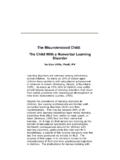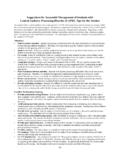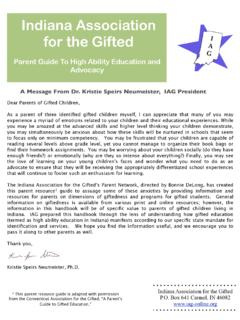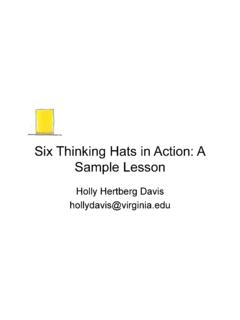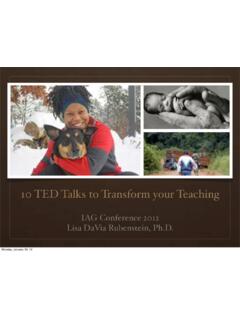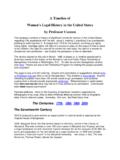Transcription of Lesson Plans for teaching students how to Determine Bias ...
1 Lesson Plans for teaching students how to Determine Bias Background for the Lessons I would see this as part of a series of lessons under an umbrella of Becoming A Credible Researcher with an overarching goal of helping students create sustainable writing pieces and projects in any discipline. This series of lessons is designed to provide criteria to examine sources for their credibility/quality of information by evaluating them for bias. This skill would be useful to students as they conduct research for their National History Day projects. In the intro Lesson a discussion about the word bias itself followed by some discussion to activate prior knowledge and points of reference for the students . In the guided practice Lesson suggestions students could work in small groups along with the teacher to identify some bias in similar documents. By the transfer Lesson , students have become skilled at identifying and evaluating bias in historical documents and begin evaluating for bias in other media forms such as television, radio, Internet and other print (non-historical) sources.
2 They feel confident rating bias and evaluating its effectiveness for various purposes. Excerpt from my Module 6A assignment Skill Definition Synonyms Determining Bias Determining bias is the ability to recognize value-laden information presented within an argument that may have origins in a specific viewpoint or be rooted in perceived stereotype. The researcher must decide whether the bias is helpful to their position/argument. Identifying partiality, prejudice, preconceptions, nepotism Introduction Teacher will put the above graphic (with middle and right boxes blank) on the board and state that today s goal is going to be investigating why the ability to Determine bias is critical to developing ourselves as researchers. Teacher will say Our challenge for so many of the papers we write and projects we do is finding information that is credible.
3 One thing that can increase or reduce credibility as researchers is evaluating our sources for bias. Any ideas for a definition or synonyms for the word bias ? Teacher will accept all responses and write down on the board. Expected responses include: prejudice, stereotypes, favoritism, prior experiences, manipulated data, viewpoints, perceptions, partiality, favoring one side of an argument more than the other, non being objective, not being completely factual, propaganda. Teacher will say Let s look at the following document and take into consideration everything we have discussed and put up on the board. Teacher distributes photocopies of an excerpt of thomas Paine s common Sense (download from ) and instructs students to use a highlighter to identify any examples of bias in the document. Excerpt of " common Sense" In the following pages I offer nothing more than simple facts, plain arguments, and common sense: and have no other preliminaries to settle with the reader, than that he will divest himself of prejudice and prepossession, and suffer his reason and his feelings to Determine for themselves that he will put on, or rather that he will not put off, the true character of a man, and generously enlarge his views beyond the present day.
4 The Sun never shined on a cause of greater worth. 'Tis not the affair of a City, a County, a Province, or a Kingdom; but of a Continent of at least one-eighth part of the habitable Globe. 'Tis not the concern of a day, a year, or an age; posterity are virtually involved in the contest, and will be more or less affected even to the end of time, by the proceedings now. Now is the seed-time of Continental union, faith and honour. The least fracture now will be like a name engraved with the point of a pin on the tender rind of a young oak; the wound would enlarge with the tree, and posterity read in it full grown characters. thomas Paine, " common Sense" (1776) After ample time the teacher asks students to give examples of bias from the document. After receiving five to ten examples (words, phrases, inferences, etc.) teacher goes back to students to question how they came to identify the bias (what were they thinking as they read the identified words, phrases, or the points at which they made inferences of bias).
5 Teacher lists these responses on the board as clues and cues . Teacher distributes photocopies of an excerpt of James Chalmers Plain Truth (download from ) and instructs students to again use a highlighter to identify any bias in the document. His [Paine s] first indecent attack is against the English constitution; which with all its imperfections, is, and ever will be the pride and envy of He indeed insidiously attributes this pre-eminent excellency, to the constitution of the people, rather than to our excellent constitution. To such contemptible subterfuge is our Author reduced. I would ask him, why did not the constitution of the people afford them superior safety, in the reign of Richard the Third, Henry the Eighth, and other tyrannical princes? Many pages might indeed be filled with encomiums bestowed on our excellent constitution, by illustrious authors of different nations.
6 This beautiful system (according to MONTESQUIEU) our constitution is a compound of Monarchy, Aristocracy, and Democracy. Were I asked marks of the best government, and the purpose of political society, I would reply, the increase, preservation, and prosperity of its members, in no quarter of the Globe, are those marks so certainly to be found, as in Great Britain, and her dependency. He says, The plain truth is, that the antiquity of English Monarchy will not bear looking into. After his terrible anathema against our venerable constitution, and monarchy; let us briefly examine a democratical state; and see whether of not it is a government less sanguinary. This government is extremely plausible, and indeed flattering to the pride of mankind. The demagogues therefore, to seduce the people into their criminal designs ever hold up democracy to them: although conscious it never did, nor ever will answer in practice.
7 If we believe a great Author, There never existed, nor ever will exist a real democracy in the World. If we examine the republics of Greece and Rome, we ever find them in a state of war domestic or foreign. Our Author therefore makes no mention of these ancient States. Until the present unhappy period, Great Britain has afforded to all mankind, the most perfect proof of her wise, lenient, and magnanimous government of the Colonies -- The proofs to which we already have alluded, viz. Our supreme felicity, and amazing increase..Innumerable are the advantages of our connection with Britain; and a just dependence on her, is a sure way to avoid the horrors and calamities of war. After ample time the teacher asks students to give examples of bias from the second document along with which clues and cues from the board they used (or any new strategy/clue he/she may have used --- adding these to the list) to identify the bias.
8 To wrap up the Lesson , the teacher asks students for suggestions to clean-up our notes on the board (making adjustments such as more precise definition(s), synonyms, and clues/cues. Once the class is in agreement that they have made the most efficient set of notes for the skill of detecting bias, students transfer the notes to their research binders. As students finish with the notes, the teacher should initiate a wrap-up conversation (or may choose to have students reflect on these questions on exit cards or as a homework assignment (Suggestion: teacher could post these as blog questions on class website and let students build off of each other s responses and intervene or adjust subsequent classroom instruction/discussion based on posts). Is bias always a bad thing? Is bias in every written word? Do you think all historical documents contain bias?))
9 How about our textbooks? Is it possible to write or create projects/products without bias? In what types of formats does bias exist? Give an example of how bias has influenced your opinion on an issue you consider important? Teacher will lead a wrap-up discussion based on the question Why is it important to evaluate what we read for bias? The goal of the conversation would be to have students arrive at the following conclusions: Detecting bias or slanted viewpoints help us to Determine whether the information we are retrieving from various modes/domains/media is reliable, and more importantly, whether we should use them to support our own ideas, positions and conclusions. It is helpful to look at every resource that we consider using in our writing and project development for bias. Once we have evaluated any bias of a resource (written, audio, visual, etc) we can make a more informed decision about whether we should use it as a resource and even more importantly be prepared for how our audience might react (support or challenge) to its use in making our point.
10 Guided Practice Preview the Skill review orally and summarize the previous Lesson Rehearse the Skill recall and discuss orally definition, synonyms, cues/clues, and how the skill is beneficial to conducting quality research Execute the Skill using the cueing strategy, procedural checklist, process questions and graphic organizers students will evaluate two to four more Revolution Era documents for bias (Declaration of Independence, Pelham s A Bloody Massacre, newspaper articles, etc.) Ponder the process of the skill using class discussion format, think-pair-share, or exit cards students will ponder/reflect on exactly how they executed the skill to evaluate the new documents for bias Transfer students will work in groups and using the cueing strategy, procedural checklist, process questions and graphic organizers each group presents their evaluation of found bias in a format of their choosing (oral presentation, Power Point, Bias Busters a spoof on Myth Busters, etc.)
